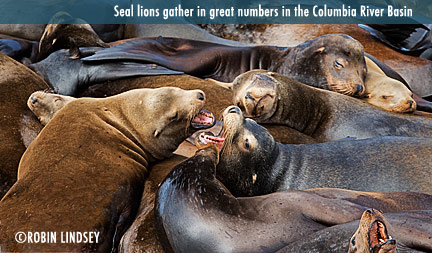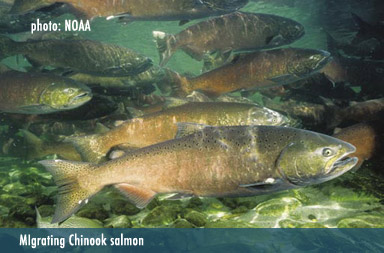BONNEVILLE DAM: NO WIN SITUATION
FOR SEA LIONS OR SALMON
 Sea lions are smart. Smart enough that the U.S. and Russian navies train them for military uses. And certainly, sea lions are smart enough to know that finding a convenient meal sure beats tracking down an elusive one.
Sea lions are smart. Smart enough that the U.S. and Russian navies train them for military uses. And certainly, sea lions are smart enough to know that finding a convenient meal sure beats tracking down an elusive one.
An inter-species standoff continues at the Bonneville Dam, which spans the wide Columbia River between Washington and Oregon. Salmon are forced to fight their way up through a 6-story fish ladder before proceeding to spawning grounds further east into Idaho and Canada. Hungry California and Steller sea lions (recently delisted from threatened species status), and occasional seals, gather at the base of the dam and feed on the stalled, trapped fish. And biologists are at an impasse as well.
The topic of pinnipeds foraging around dams and locks, where salmon and other fish congregate, has been an enduring source of debate for decades in the Pacific Northwest. Federal mandates have been periodically allowed for the culling of sea lions near Bonneville Dam in order to protect depleted runs of threatened and endangered salmon and steelhead.
This quandary about how to protect endangered fish populations and still protect marine mammals has been extremely divisive in public opinion, just like the Columbia River itself which slices through the landscape.
DISCOURAGING HUNGRY SEA LIONS IS A DAUNTING TASK
Despite years of biologists' best efforts to develop ways to discourage the opportunistic sea lions, including non-lethal deterrents such as rubber bullets and firecrackers shot from rifles (which are only temporarily effective), there seems to be no foreseeable solution. As a last resort, Federally-endorsed periodic euthanasia by lethal injection of known "repeat offender" sea lions has been ordered. Many scientists and advocates believe that this culling responds neither to the real source of declining fisheries nor the need to provide protection and humane treatment to seals and sea lions - protected under the Marine Mammal Protection Act.
Many have argued that recreational fishermen between the mouth of the Columbia and Bonneville Dam take as high a percentage of migrating fish as do the sea lions, who should not be targeted and killed for their natural foraging behavior.
However, that may no longer be true, as sea lion numbers continue to grow exponentially in the area. During the spring of 2015, sea lion counts at Astoria, Oregon, at one mooring basin alone rose to approximately 2,400 animals - an increase of almost 1,000 over the year before.
For a look at both sides, view Oregon Public Broadcasting's Earthfix, video segment here.
DAMS KILL MIGRATING FISH
 A significant percentage of adult fish die trying to pass through the dam upriver to spawn. And too high a percentage of juvenile salmon, known as smolt, die trying to go the opposite direction to the Pacific Ocean. Instead of reaching their destination, they are backed up into unnatural warm-water reservoirs before navigating over dams with dangerous turbine engines.
A significant percentage of adult fish die trying to pass through the dam upriver to spawn. And too high a percentage of juvenile salmon, known as smolt, die trying to go the opposite direction to the Pacific Ocean. Instead of reaching their destination, they are backed up into unnatural warm-water reservoirs before navigating over dams with dangerous turbine engines.
Sockeye salmon travel over 900 miles from the ocean to reach their spawning grounds in Idaho. Fish must fight their way through an exhausting series of dams to reach their destination. This massive obstruction in the Columbia River and the four dams on the Lower Snake River continue to decimate fish stocks that many species depend on as a food source.
Complicating matters even further, the extreme drought causing reduced snowpacks in the Northwest has raised Columbia River Basin water temperatures to near-lethal levels, killing many thousands more migrating fish.
Government agencies and biologists, stuck in the middle, are earnestly seeking answers to help threatened and endangered salmon and steelhead species recover. However, for now, it is a no-win situation for all involved - most certainly, for the fish fighting their way over dam after dam and for the seals and sea lions, seeking an easy meal as their food sources dwindle.
RESOURCES AND LINKS
LINKS ABOUT BONNEVILLE DAM, MIGRATING SALMON AND PINNIPEDS
To learn more about this complex and urgent situation, as well as resources on dams and how they affect fish and rivers, please explore the links page.
FOR SEA LIONS OR SALMON

An inter-species standoff continues at the Bonneville Dam, which spans the wide Columbia River between Washington and Oregon. Salmon are forced to fight their way up through a 6-story fish ladder before proceeding to spawning grounds further east into Idaho and Canada. Hungry California and Steller sea lions (recently delisted from threatened species status), and occasional seals, gather at the base of the dam and feed on the stalled, trapped fish. And biologists are at an impasse as well.
The topic of pinnipeds foraging around dams and locks, where salmon and other fish congregate, has been an enduring source of debate for decades in the Pacific Northwest. Federal mandates have been periodically allowed for the culling of sea lions near Bonneville Dam in order to protect depleted runs of threatened and endangered salmon and steelhead.
This quandary about how to protect endangered fish populations and still protect marine mammals has been extremely divisive in public opinion, just like the Columbia River itself which slices through the landscape.
DISCOURAGING HUNGRY SEA LIONS IS A DAUNTING TASK
Despite years of biologists' best efforts to develop ways to discourage the opportunistic sea lions, including non-lethal deterrents such as rubber bullets and firecrackers shot from rifles (which are only temporarily effective), there seems to be no foreseeable solution. As a last resort, Federally-endorsed periodic euthanasia by lethal injection of known "repeat offender" sea lions has been ordered. Many scientists and advocates believe that this culling responds neither to the real source of declining fisheries nor the need to provide protection and humane treatment to seals and sea lions - protected under the Marine Mammal Protection Act.
Many have argued that recreational fishermen between the mouth of the Columbia and Bonneville Dam take as high a percentage of migrating fish as do the sea lions, who should not be targeted and killed for their natural foraging behavior.
However, that may no longer be true, as sea lion numbers continue to grow exponentially in the area. During the spring of 2015, sea lion counts at Astoria, Oregon, at one mooring basin alone rose to approximately 2,400 animals - an increase of almost 1,000 over the year before.
For a look at both sides, view Oregon Public Broadcasting's Earthfix, video segment here.
DAMS KILL MIGRATING FISH

Sockeye salmon travel over 900 miles from the ocean to reach their spawning grounds in Idaho. Fish must fight their way through an exhausting series of dams to reach their destination. This massive obstruction in the Columbia River and the four dams on the Lower Snake River continue to decimate fish stocks that many species depend on as a food source.
Complicating matters even further, the extreme drought causing reduced snowpacks in the Northwest has raised Columbia River Basin water temperatures to near-lethal levels, killing many thousands more migrating fish.
Government agencies and biologists, stuck in the middle, are earnestly seeking answers to help threatened and endangered salmon and steelhead species recover. However, for now, it is a no-win situation for all involved - most certainly, for the fish fighting their way over dam after dam and for the seals and sea lions, seeking an easy meal as their food sources dwindle.
RESOURCES AND LINKS
LINKS ABOUT BONNEVILLE DAM, MIGRATING SALMON AND PINNIPEDS
To learn more about this complex and urgent situation, as well as resources on dams and how they affect fish and rivers, please explore the links page.